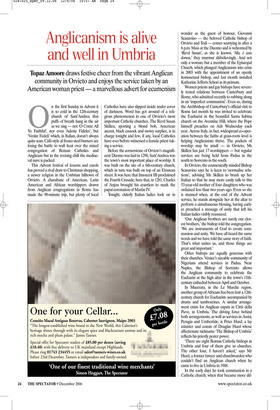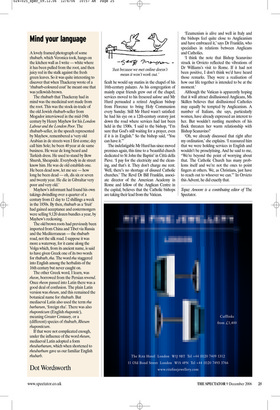Anglicanism is alive and well in Umbria
Topaz Amoore draws festive cheer from the vibrant Anglican community in Orvieto and enjoys the service taken by an American woman priest — a marvellous advert for ecumenism On the first Sunday in Advent it is so cold in the 12th-century church of Sant’Andrea that puffs of breath hang in the air as we sing — not ‘O Come All Ye Faithful’, nor even ‘Adeste Fideles’, but ‘Venite Fedeli’ which, in Italian, doesn’t always quite scan. Café-style al fresco steel burners are losing the battle to waft heat over the mixed congregation of Roman Catholics and Anglicans but in the evening chill the mediaeval nave is packed.
This Advent festival of lessons and carols has proved a rival draw to Christmas shopping, a newer religion in the Umbrian hilltown of Orvieto. A charabanc of American, Latin American and African worshippers drawn from Anglican congregations in Rome has made the 90-minute trip, but plenty of local Catholics have also slipped inside under cover of darkness. Word has got around of a religious phenomenon in one of Orvieto’s most important Catholic churches. The Revd Susan Skillen, sporting a blond bob, American accent, black cassock and snowy surplice, is in charge tonight and few, if any, local Catholics have ever before witnessed a female priest taking a service.
Before the cornerstone of Orvieto’s magnificent Duomo was laid in 1290, Sant’Andrea was the town’s most important place of worship. It was built on the site of a 6th-century church, which in turn was built on top of an Etruscan street. It was here that Innocent III proclaimed the Fourth Crusade; here that, in 1281, Charles of Anjou brought his courtiers to mark the papal coronation of Martin IV.
Tonight, elderly Italian ladies look on in wonder as the guest of honour, Giovanni Scanavino — the beloved Catholic bishop of Orvieto and Todi — comes scurrying in after a 6 p.m. Mass at the Duomo and is welcomed by ‘Revd Susan’, as she is known. ‘Ma, è una donna,’ they murmur disbelievingly. And not only a woman, but a member of the Episcopal Church, which plunged Anglicanism into crisis in 2003 with the appointment of an openly homosexual bishop, and last month installed Katharine Jefferts Schori as its primate.
Women priests and gay bishops have severely tested relations between Canterbury and Rome, who admitted recently to rubbing along in an ‘imperfect communion’. Even so, during the Archbishop of Canterbury’s official visit to Rome last month he was invited to celebrate the Eucharist in the beautiful Santa Sabina church on the Aventine Hill, where the Pope himself preaches on Ash Wednesday each year. Across Italy, in fact, widespread co-operation between the faiths at grass-roots level is helping Anglicanism thrive. The pockets of worship may be small — in Orvieto, Ms Skillen has just 17 worshippers — but regular services are being held from Padua in the north to Sorrento in the south.
In Orvieto, the ecumenically minded Bishop Scanavino says he is keen to ‘normalise relations’, advising Ms Skillen to brush up her Italian so that he may more easily talk to this 53-year-old mother of four daughters who was ordained less than two years ago. Even so she is stunned when, at the end of the Advent service, he stands alongside her at the altar to perform a simultaneous blessing, having earlier preached a message of unity that left his Italian ladies visibly reassured.
‘Our Anglican brothers are surely our closest brothers,’ the bishop told the congregation. ‘We are instruments of God to create communion and unity. We have all heard the same words and we have told the same story of faith. That’s what unites us, and those things are great and important.’ Other bishops are equally generous with their churches. Venice’s sizeable community of Nigerians attend services in Padua. Near Naples, the Bishop of Sorrento allows the Anglican community to celebrate the Eucharist at the high altar in the town’s 11thcentury cathedral between April and October.
In Macerata, in the Le Marche region, another group of Africans has been lent a 12thcentury church for Eucharists accompanied by drums and tambourines. A similar arrangement exists for Anglican expats in Città della Pieve, in Umbria. The driving force behind both arrangements, as well as services in Assisi, Perugia and Umbertide, is Peter Hurd, a lay minister and cousin of Douglas Hurd whose affectionate nickname ‘The Bishop of Umbria’ reflects his priestly pester power.
‘There are eight Roman Catholic bishops in Umbria and four of them give us churches. The other four, I haven’t asked,’ says Mr Hurd, a former lawyer and churchwarden who couldn’t find an Anglican church when he came to live in Umbria in 1988.
In the early days he took communion in a Catholic church; when that became more dif ficult he would say matins in the chapel of his 16th-century palazzo. As his congregation of mainly expat friends grew out of the chapel, services moved to his frescoed salone and Mr Hurd persuaded a retired Anglican bishop from Florence to bring Holy Communion every Sunday. Still Mr Hurd wasn’t satisfied: he had his eye on a 12th-century oratory just down the road where services had last been held in the 1500s. ‘I said to the bishop, “I’m sure that God’s still waiting for a prayer, even if it is in English.” So the bishop said, “You can have it.”’ The indefatigable Mr Hurd has since moved premises again, this time to a ‘beautiful church dedicated to St John the Baptist’ in Città della Pieve. ‘I pay for the electricity and the cleaning, and that’s it. They don’t charge me rent. Well, there’s no shortage of disused Catholic churches.’ The Revd Dr Bill Franklin, associate director of the American Academy in Rome and fellow of the Anglican Centre in the capital, believes that the Catholic bishops are taking their lead from the Vatican. ‘Ecumenism is alive and well in Italy and the bishops feel quite close to Anglicanism and have embraced it,’ says Dr Franklin, who specialises in relations between Anglicans and Catholics.
‘I think the note that Bishop Scanavino struck in Orvieto reflected the vibrations of Dr Williams’s visit to Rome. If it had not been positive, I don’t think we’d have heard those remarks. They were a realisation of how our life together is intended to be at the moment.’ Although the Vatican is apparently hoping that it will attract disillusioned Anglicans, Ms Skillen believes that disillusioned Catholics may equally be tempted by Anglicanism. A number of Italians, she says, particularly women, have already expressed an interest to her. But wouldn’t rustling members of his flock threaten her warm relationship with Bishop Scanavino?
‘Oh, we already discussed that right after my ordination,’ she explains. ‘I reassured him that we were holding services in English and wouldn’t be proselytising. And he said to me, “We’re beyond the point of worrying about that. The Catholic Church has many problems itself and we’re not the ones to point fingers at others. We, as Christians, just have to reach out to whoever we can.”’ In Orvieto this Advent, he did exactly that.
Topaz Amoore is a contributing editor of The Spectator.



























































































 Previous page
Previous page